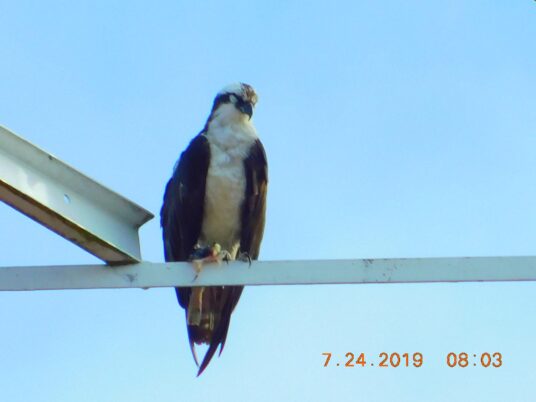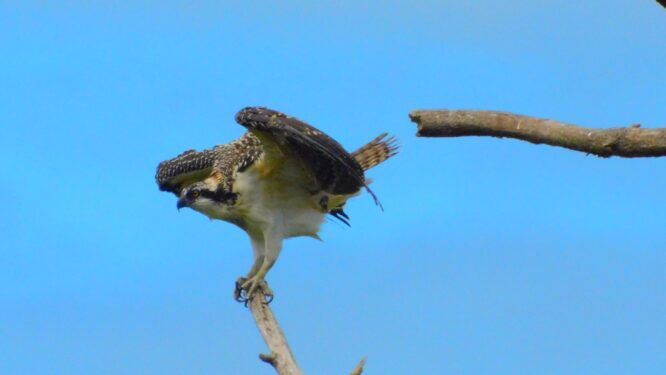The Osprey Return
by Marcia Wilson

This April, the ospreys returned to Clover Park Technical College’s home on the Lakewood campus. This is not taken for granted. The birds are powerful, but have a long, grueling trek from their winter home to Western Washington.
April is a changeable month. Snow and sleet is not—quite—outside possibility. Spring storms can blow even the strongest birds off their course. Cold weather means food is harder to find. Warm weather is ideal for hunting, but not reliable.
Very far south
The majority of osprey from Alaska to Western Washington have been found in the region that stretches from Southern Texas to Central America. Young ospreys born that year usually “pick and choose” where they will return on their first visit; they will not be allowed to use their parents’ nests but settle within 40km and forge their own families.
How far is too far?
The western osprey are in the longest-spread migratory map of the Americas. Ospreys as far north as Alaska have been found in Central America, which is about 3,992 miles, or 6424.5 kilometers.
Timing is everything
Spring migrations go much faster than winter, about 200 more miles a day faster, because they need to claim their nests before something else does. It also coincides with a necessary warming of the waters.
Flett Creek is a convenient food source. In warm weather the fish rise to the top to feed and sip on oxygen. Osprey sit in the trees overlooking the banks and simply wait for a fish large enough to hunt to get within range. While there is a large assortment of fish in the Flett, catfish is the favorite. These are non-native to Washington State, so the Environmental Science & Tech students offer them a thumbs-up of approval.

Bates College: Et tu, CPTC?
Bates College posted here their encounter of their osprey eating a goldfish illegally released into Lake Andrews. As Bates Professor of Biology Don Dearborn summed up: “It’s super cool!”
Campus Security Officer Demetrius Bell noted the female shows up first and described her reaction to the winter-damaged nest as “very unhappy!” He sees the male about three weeks after, and once the nest is in proper shape they settle down to a long-familiar routine of parenting. In a good year three chicks will be seen perched on the edge of the radio tower. They look very different from their parents, with speckles on their new feathers. Their eyes are also orange instead of adult’s yellow, but that would be hard to discern from the ground.
Human impact continues to shrink viable habitat. Billboards, platforms, and radio towers replace trees in a modern adaptation that has been helping them, but osprey must also defend their nests against predators that are just as adaptable to an urban setting: Bald Eagles will steal a nest for their own—or make a lunch out of an osprey chick.
Eagles are not shy about stealing from anything, be it humans, wildlife, or other birds. Students on field trips to the CPTC Outdoor Lab reported eagles harassing osprey leaving the creek with a hard-won fish. On occasion, the eagles try too hard, and the osprey simply go to another fishing-spot. Considering they have been seen with flatfish, Chambers Bay must be a preferred locale.
SAHW: Stay at Home Woman-at-Arms
The female stays on the nest while the male hunts fish for all. Once the chicks start hatching their high-pitched peeps and cheeps are audible from three buildings away, which begs the question of how loud they are to their parents. The calls also attract potential nest-robbers like the eagles. Mom never drops her guard in defense of her chicks. Her behavior is far more aggressive when threats like strange birds arrive on campus. With a wingspan of over six feet long, she is properly intimidating.
A Specially-designed hawk
Osprey have evolved to maximize their fishing diet to the extent that they do not behave, eat, or even look like other raptors.

Their feet are the largest of any other raptor, but they need them for hunting. Those feet have more unique adaptations as well: Their talons have a curvature unique to their species, all the better to cling to slippery fish. Where a human would have pads on their fingertips, osprey have tiny, sandpaper-like spikes. If this wasn’t enough, their outer toe is almost double-jointed, which helps it bend in angles impossible for other birds—but again, all the better to grab a fish and control its aerodynamics. Osprey know that they will fly faster and easier if the fish is facing-forward, so having a talon that works like a thumb is useful!